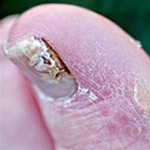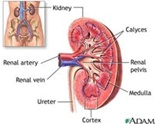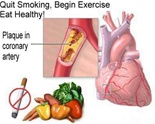
Diabetes and Foot Problems
Diabetes and Foot Problems
Diabetes and foot problems go hand and hand. And, that is because diabetes is all about high levels of sugar in the blood. The sugar damages the arteries. The damaged arteries reduce blood flow. Poor blood flow prevents healing. The feet and hands are furthest away from the heart and so the oxygen and nutrients get to them very late. Therefore, proper foot care, including inspection for cuts and blisters, should be part of your daily personal-care routine.
If you have recently been diagnosed with diabetes, it may seem strange to have to pay special attention to the feet. But, it is important to know that diabetics experience nerve damage and blood flow problems more frequently than the non-diabetics. So, even if you do not have foot problems now, they could develop secretly if you do not inspect your feet regularly.
Buy Comfortable Diabetes Shoes!
 Two main foot problems caused by diabetes:
Two main foot problems caused by diabetes:
Nerve damage – neuropathy (nu-Rop-a-thee) affects many diabetics at some point or another over the course of their lives. Among the leading causes of nerve damage are high blood sugar levels and poor blood circulation. When you have nerve damage in your feet, you will lose sensation and may have difficulty using your muscles. When your muscles become weakened or misaligned, you will likely put too much pressure on one part of the foot, which can cause blisters and sores to develop.
When you have nerve damage, you may not even detect everyday wear and on your feet, such as cuts and blisters. If you are not aware of foot injuries, then the injuries will go untreated and even small injuries can lead to a big-time infection. An estimated 10% of diabetics develop potentially dangerous foot ulcers as a result of nerve damage that masked smaller injuries.
Poor blood flow – peripheral (puh-rif-er-uhl) vascular disease, makes it hard for cuts and infections to heal simply because oxygen-rich blood cannot reach the area of infection efficiently. If an infection goes for a prolonged amount of time without treatment or proper blood flow to the area, you may develop gangrene (GANG-green) – a condition in which the skin and tissue of the infected area dies and becomes black and smelly. Amputation is the most common treatment for gangrene.
Athlete’s Foot – is characterized by itchy feet and cracking skin.  The condition exposes the foot to infection, but is treatable with medicines and creams.
The condition exposes the foot to infection, but is treatable with medicines and creams.
Blisters – Blisters are one of the most common foot ailments that affect diabetics. The condition usually occurs when shoes rub against moist skin, creating enough friction to weaken the bond between layers of skin. If you develop a blister, it is important to avoid popping it. Instead, treat the blister using bandages and anti-bacterial cream.
Bunions –A bunion occurs when toes become misaligned. Most commonly, the big toe will be pushed towards the second toe, causing an outward bulge at the joint of the big toe that can become sore and prone to calluses. In most cases, bunions are caused by wearing uncomfortable shoes, such as heels or shoes that are too narrow. Bunions may also be genetic. You can treat bunions using toe separators between the second toe and big toe. In some cases, surgery is required to realign the toes and relieve pain.
Calluses – A Callus is a build-up of skin that becomes hardened. Calluses are common foot conditions for diabetics and, are caused when weight is placed unevenly on a certain area of the foot. Calluses are generally caused by shoes that do not fit properly. To treat your calluses, regularly scrub your feet with a pumice stone and use orthopedic pads in your shoes for increased comfort. In extreme cases, your doctor may prescribe medicine.
Corns – A corn is a small growth that is similar to a callus in that corns are characterized by a build-up of hard skin. However, a corn generally develops around the bony area of the toes. Treatment for corns is similar to treatment for calluses and can also involve special medication.
Dry Skin – Dry skin occurs when there is not enough moisture in the skin. Dry skin, while common, can also be dangerous when it cracks and leads to infection. To avoid dry skin, always wash your feet in warm water and use lotions as often as possible. And, drink plenty of water to stay hydrated.
Foot Ulcers – Foot ulcers are similar conditions to blisters, in that they are begin with a weakening of the skin caused by friction and moisture. However, a foot ulcer is characterized by a complete break in the outer layer of skin. When the skin breaks, the area can quickly develop an infection and should be treated carefully. See your doctor for recommended wound care treatments, such as creams, padding and medications.
Foot ulcers are similar conditions to blisters, in that they are begin with a weakening of the skin caused by friction and moisture. However, a foot ulcer is characterized by a complete break in the outer layer of skin. When the skin breaks, the area can quickly develop an infection and should be treated carefully. See your doctor for recommended wound care treatments, such as creams, padding and medications.
Fungal Infections – Infected nails take on a yellow-brownish or opaque color and are normally brittle and thick. The nail might also separate from the nail bed or completely crumble. If you have a fungal infection, have your doctor prescribe anti-fungal medication. You may also have to remove tissue around the infected area.
Ingrown Toenails – Ingrown toenails are common among all types of people, not just Diabetics. In general, they are caused when tight-fitting shoes push toenails into the skin around the edges of the toenail bed, cutting the skin. When the skin is pierced, the condition can lead to infection, swelling and extreme discomfort. The best way to avoid ingrown toenails is to properly trim your toenails regularly. In some cases, you may need surgery to extract part of the toenail that causes irritation.
Plantar Warts – Plantar warts are small growths of skin that generally develop in clusters. They are similar to the look and texture of calluses, except for the presence of a black spot in the center and the appearance of small pinholes (similar to the look of a dandelion head.) Plantar warts are the result of an infection that is caused by a virus in the skin. Doctors normally treat plantar warts with over-the-counter or prescribed medications.
- Here are some helpful tips to help you care for your feet:
- Wash your feet with warm, soapy water every day.
- Keep your feet dry, but moisturized.
- Do not moisturize between your toes.
- Avoid soaking your feet, as soaking can weaken the skin.
- Use a pumice stone to soften your calluses and corns regularly.
- Trim your toenails.
- Avoid wearing sandals or going barefoot, as exposed skin is susceptible to cuts and infection.
- Wear socks and or stockings with your shoes.
- When necessary, use padding on bunions, blisters, calluses and other injuries.
- Wear shoes that fit comfortably.
- Keep your feet warm by wearing socks or slippers.
- Elevate your feet as much as possible to increase blood-flow.
- Keep your feet active by rotating your ankles and wiggling your toes.
- Avoid sitting cross-legged for a prolonged period of time, as sitting cross-legged can cut off blood flow to your feet.
- Before putting on shoes, make sure that the shoes do not have sharp edges or items in them that could cut into your feet. If you have nerve damage, you may not be able to feel these sharp items when your shoes are on.
- Examine your feet daily for cuts and blisters.
- Visit your doctor regularly.
A podiatrist is a doctor that specializes in foot care. It is recommended that diabetics visit a podiatrist or their primary care physician every 2-3 months for a complete foot check-up, even if they do not have regular foot problems.
Be sure to contact your doctor if you experience any of the following problems:
- Uneven skin color or changes in skin color
- Unusually hot or cold skin
- Swelling
- Numbness
- Pain
- Slow-healing wounds
- Sores that are draining fluid
- Infected toenails
- Unusual foot odor, especially if the skin is cracked
Talk to your doctor for more information about how you can take care of your feet. Remember: taking good care of your feet will help to prevent long-term problems like amputation.

Diabetic Supplies Online | Diabetes Medical Supplies & Products – Blood Glucose Test Strips & Meters
Diabetes and Periodontal Disease
Diabetes and Periodontal Disease
Tooth decay, diabetes, hyperactivity and more are being linked to heavy soda consumption
Part of the blame is attributed to the sheer volume of carbonated soft drinks consumed in this country. Every man, woman and child in the United States drinks about 3.7 gallons of fluid a week, according to the Beverage Marketing Corp. Of that amount, about 28.3 percent is soda, making it more popular than milk, bottled water, fruit juice, sports drinks and even tap water.

Diabetes Kidney Disease
Diabetic Kidney Disease
Kidney Care
Diabetic kidney disease is extremely common among both Type 1 diabetics and Type 2 diabetics. In fact, diabetes is the leading cause of kidney failure, a condition also known as nephropathy, (nuh-frop-uh-thee) which affects almost 200,000 Americans each year.
This means that 20% to 40% of people with Type 1 diabetes will develop kidney failure, usually before the age of 50. Kidney failure generally occurs 15 to 25 years after a person has been diagnosed with diabetes if he or she is going to have it. If you are one of these people, you are not alone. There are also treatments available that can help you stay active and healthy.
How Kidneys Work
Kidney disease occurs when the kidneys stop functioning properly. Because the kidneys are the primary means of filtering toxins from the body, kidney failure means that the body has an increase in the level of toxicity.
In particular, the kidneys filter out a blood protein called albumin (al-byoo-muhn) and Creatinine (kree-at-n-een, -in). When the kidneys begin to fail, the kidneys stop processing these proteins properly and they leak into the urine. Kidney function continues to degenerate and the body retains waste that it cannot filter properly. As such, the level of toxins rises, as does the body’s blood pressure.
Think of your kidneys as a sponge that absorbs toxic chemicals from your bloodstream. If the sponge stops absorbing toxic chemicals, then they will stay in the bloodstream and remain dangerously toxic.
Tests for Kidney Health
A sensitive blood test for protein or albumin in the urine involves laboratory measurement and calculation of the protein-to-creatinine or albumin-to-creatinine ratio. Creatinine is a waste productin the blood created by the normal breakdown of muscle cells during activity. Healthy kidneys take creatinine out of the blood and put it into the urine to leave the body. When the kidneys are not working well, creatinine builds up in the blood.
Treatment
The treatment for kidney failure is limited and involves either dialysis (dahy-al-uh-sis) or a kidney transplant. Dialysis is a treatment that involves sending a patient’s blood through a filtration machine in order to mechanically remove the toxins from the machine. Most patients requiring dialysis must have the procedure performed daily or several times a week.
High blood pressure has also been found to be a huge contributing factor to kidney failure. Therefore, lowering blood pressure can help to reduce the toll on the kidneys. Many diabetic patients will take blood pressure medicine in addition to increasing their levels of physical activity and maintaining a nutritious diet.
Many diabetics are also warned about the dangers of high-protein diets. It can be difficult for the kidneys to filter excess protein; therefore, many doctors recommend that diabetics consume a normal level of protein, but do not adhere to high-protein diets. In fact, reducing the amount of protein in the diet may even help to delay the onset of kidney failure. If you are considering reducing your protein in-take, consult your physician first.
Additionally, doctors recommend that diabetics facing kidney failure maintain low-sugar meal plans in order to reduce their blood glucose levels. Diabetics should also continue their normal medications, such as insulin injections or pills, in order to keep their blood glucose levels as normal as possible. By following a very strict, low-glucose diet, the Diabetes Control and Complications Trial (DCCT) found that diabetics can reduce the risk of developing or worsening kidney failure.
Know Your Blood Pressure to Control It!
Staying knowledgeable about your body’s functions is the key to staying healthy. In order to reduce your risk of developing kidney failure or to delay the severity of the condition, it is a good idea to have regular check-ups.
Here are some more tips to help you stay on top of your condition:
- Have your A1C level measured at least twice a year.
- Keep your A1C level at 7% or less.
- Consult with your doctor about the best treatment for you including:
- meal plans
- medication
- exercise
- blood glucose monitoring
- Have your urine checked once a year.
- Have an annual blood check.
- Pay close attention to your nutrition, including how much protein you eat.
Your kidneys are essential organs that help to filter waste from your body and form urine. Diabetics sometimes face kidney failure due to prolonged wear and tear on the organs. When a diabetic has kidney failure, he or she has a number of treatment options, including a kidney transplant or lifelong dialysis.
The goal of all treatment is to help filter toxins from your body by removing excess fluid, minerals, and other wastes. Kidneys also help to keep the hormones regulated throughout your body so that your body can function properly. When the kidneys fail, often, blood pressure will rise, your body may swell as you retain excess fluid, and you may not make enough red blood cells to stay healthy. Once the kidneys have failed, you will need to decide on a course of treatment.
The three possible treatments you can choose from include:
Hemodialysis (hee-moh-dahy-al-uh-sis), Peritoneal Dialysis (per-i-tn-ee-ahl dahy-al-uh-sis), and kidney transplantation.
Hemodialysis (hee-moh-dahy-al-uh-sis)
Hemodialysis filters your blood through a machine in an effort to rid your body of waste, excess salt and excess water. The machine serves as an artificial kidney for the duration of time that you are hooked up to it. The machine pulls your blood through tubes connecting to your body (usually at the forearm) and into the dialyzer. The machine then filters the waste and water from the blood and directs the flow of blood back into your body
A major benefit of Hemodialysis is that it helps to regular your blood pressure and keep the proper levels of vitamins and nutrients in your body, including potassium, sodium, calcium, and bicarbonate. Generally, the procedure is performed three times a week and can last from three to five hours.
Peritoneal Dialysis (per-i-tn-ee-ahl dahy-al-uh-sis) is similar to Hemodialysis in that it helps to filter waste, water, and other chemicals from your body. However, peritoneal dialysis interfaces directly with the lining of your abdomen in order to filter your blood. The lining is called the peritoneal membrane and will serve as your artificial kidney when your other kidneys fail.
In order for your abdomen to become your temporary artificial kidney, the abdomen needs to be filled with a dialysis solution, which is a mixture of minerals and sugar that is dissolved in water. The solution is input into your abdomen by means of a flexible tube. Once in your abdomen, the sugar will draw wastes, chemicals, and excess water directly from the blood vessels in your peritoneal membrane and into the dialysis solution.
The solution will stay in your abdomen for several hours before it is drained through the tube. When the solution is drained, it will take the wastes from your blood with it.
Click here for more information about peritoneal dialysis.
Kidney TransplantationA kidney transplant is a process by which a kidney (or both) is removed from the body and replaced with another person’s kidney. In most cases, the donated kidney will work in the same way that you failed kidney once worked, as long as the body accepts the new kidney.
When you receive a kidney transplant, a surgeon will connect the new kidney to the artery and vein that will interface with your blood stream and bladder. The old kidneys are generally left in place. In some cases, the new kidney will start filtering blood and making urine right away. In other cases, it can take weeks for the new kidney to start functioning properly. If you receive any organ transplant, you will have to take medications for the rest of your life in order to ensure that your body continues to accept the new organ.
Exercise to Reduce Your Blood Sugar Levels

Management for Diabetic Incontinence

Depression and Diabetes
Depression and Diabetes
According to the National Institute of Mental Health (NIMH), many diabetics face serious mental health challenges that are associated with diabetes and its complications. In fact, having diabetes doubles the risk of developing depression, according to the NIMH.
Questions About Diabetes?
Diabetics have physical and mental conditions that they must overcome when it comes to managing their diabetes.  Not only do diabetics often have to deal with the physical effects of the disease, such as high blood pressure, stress, and obesity, but they also have to face the knowledge that Diabetes is a disease for which there is no cure.
Not only do diabetics often have to deal with the physical effects of the disease, such as high blood pressure, stress, and obesity, but they also have to face the knowledge that Diabetes is a disease for which there is no cure.
Often, once a person begins to show signs of diabetic side effects, the person will also feel depressed. As diabetes worsens, depression often worsens.
Do you believe that you may have depression? Take a moment to read through the following depression checklist or take our depression quiz:
- Feelings of persistent sadness or anxiety
- Feelings of “emptiness”
- Feelings of guilt, worthlessness and helplessness
- Loss of interest in hobbies and other activities, including sex
- Fatigue and lethargy
- Insomnia, waking early, or oversleeping
- Difficulty concentrating or remembering facts
- Indecisiveness
- Loss of appetite or weight
- Suicidal thoughts or attempts
- Restlessness or irritability
- Treatment
There are many treatments for depression, depending on the type and severity of the depression that you have. Some people will feel better simply by speaking with a therapist. Others may need special medications to help control their depression. Some people even claim that herbal supplements, such as St. John’s wort, help to clear their depression effectively.We are are not aware of the scientific proof.
Here is a site that specializes in helping individuals deal with stress management. Reduce Stress – Partnering with you on stress & about living with stress, symptoms, treatment, stress management, dealing with stress, and more.
Alternatively, you can check this one out Feel Healthy Again. Depression, Stress, Weight, Exercise, Healthy Eating and Diets all affect our health and how upbeat we feel. “Feel Healthy Again” is another site that takes a holistic view on addressing depression and how to feel healthy again.
Before beginning any herbal or medicinal treatment, it is important to discuss your condition with your physician. Some medications interact badly or could cause harmful side effects in your body. Therefore, always ask your doctor for advice when it comes to beginning a new treatment plan.
Help Someone Feel Better with a Diabetic Gift Basket
The discussion of depression and diabetes is important and helpful for many  people with Type 2 diabetes, Type 1 diabetes, or gestational diabetes. Www.typefreediabetes.com usually discusses methods of maintaining a diabetic’s physical health in www.typefreediabetes.com’s Diabetes Information section.
people with Type 2 diabetes, Type 1 diabetes, or gestational diabetes. Www.typefreediabetes.com usually discusses methods of maintaining a diabetic’s physical health in www.typefreediabetes.com’s Diabetes Information section.
However, maintaining a diabetic’s mental well-being is equally as important as Where’s My Basket? Maintaining their physical health – and countless studies indicate that good diabetes mental health can often result in good physical health. For that reason, diabetics need to be particularly aware of their mental attitude and strive on a continual basis to stay positive.
Thanks!
If you have a loved one that has Type 1 diabetes, or Type 2 diabetes or gestational diabetes, there are many things that you can do to help them stay positive, happy, and healthy. However, sending a wellness basket is not only a fun way to show your support, but it also gives your diabetic loved one a jump start on their wellness and can remind them that even though they have been diagnosed with diabetes, they can still enjoy many delicious foods and treats.
Our wellness baskets come loaded with tasty diabetic-friendly treats, including teas, diabetes snack items, diabetes desserts, sugar-free jams, and other low-sugar goodies.
Our baskets are affordably priced and designed with your diabetic loved one in mind. Plus, the high-quality basket is durable and makes a great place to store low-sugar treats for years to come. So go ahead – show your diabetic loved one that they can still indulge and delicious goodies by sending a thoughtful wellness basket today!
3 Steps to Minding Mental Health
- Everyone feels stress, sadness, discomfort, and other emotional ups and downs as a normal part of life. However, diabetics may tend to be more susceptible to feelings of hopelessness, despair, and just plain lethargy than others.
Feeling Sad?
Many of these negative feelings come from the knowledge that they have a serious illness. Other feelings may stem from the everyday routine that Diabetics need to go through in order to stay healthy.
Here are some simple steps to help you manage your mental health:
The first step to gaining control of your mental health is to identify the cause of any distress. For example, if you are feeling sad, ask yourself why you are feeling sad.
- Are you feeling down because of low blood sugar?
- Can you just not stand to go through another daily blood glucose test?
- Are you tired of always having to make sure you have the proper medications before leaving your home for the day?
Little issues and concerns may begin to pile on top of one another if you do not take the time to address each one as it comes. Remember, it is normal to be frustrated sometimes about the burden caused by having to constantly care for your medical condition.
- However, identifying the cause of the frustration can help you get through it much faster than if you were to be frustrated for reasons that you cannot explain. Don’t be ashamed to be bothered by the little things – they are important. But be sure that you develop a plan for coping with them.
Whenever you start to feel sad, frustrated, or overwhelmed by your condition, developing a plan for coping is the next step you need to take in order to restore peaceful mental health. After you have taken time to identify the issues that are causing problems, create a solution for overcoming or managing those problems.
For example, if you are frustrated by always having to remember to leave the house with your proper medication, look for solutions that allow you to not think about it. Perhaps you can store some medications in your car (be sure your medication can be stored in hot or cold temperatures).
Maybe you can tuck a ration of medication away in a pocket of your purse. There are even medication containers for key chains that may help to ensure that you always have a dose even if you leave home without remembering to stock up.
- Also, remember that Diabetes management has a lot to do with predicting how your body will react in certain situations. Therefore, once you know how to predict behavior and reactions, you will have a much easier time coping mentally with the burden of having to care for your Diabetes.
Medical Help
Many emotional highs and lows are completely normal for all people – not just diabetics. However, if you or someone you love has fallen into a “rut” and cannot seem to break free from it, it may be time to consult a physician.
- Many people have depression or other anxiety issues without even knowing it.
Here are some common symptoms of depression to be aware of:
- Change in sleep patterns (insomnia or waking up too early)
- Loss of pleasure in hobbies or other activities
- Loss of weight or increase in weight
- Difficult focusing on work or other things, such as watching TV
- Lack of energy
- Feelings of nervousness or anxiety
- Guilt and concerns of being a burden to others
- Suicidal thoughts
Feeling Bad……Treat Yourself…To Something Good.
Depression may Trigger Diabetes in Elderly
“Older adults who report high levels of depressive symptoms are more likely to develop diabetes over time than older adults who have lower depressive symptoms,” said lead researcher Mercedes R. Carnethon of Northwestern University.
Read more in China View.
For more news on Diabetes, click on News Articles.

Blood Pressure Chart
High Blood Pressure (Hypertension) and Diabetes
Diabetes is very closely associated with high blood pressure – a condition also known as hypertension. It is estimated that about 75% of adults that have diabetes also have high blood pressure and that a person with diabetes is about twice as likely to get high blood pressure than someone without diabetes.
High blood pressure occurs when arteries get filled with residue, such as cholesterol. Cholesterol decrease the passageway through which blood can flow. As the passage gets smaller, the heart has to pump harder to push blood through the arteries, which increases blood pressure.
It may help to think of high blood pressure by thinking of your arteries as a garden hose. If the garden hose becomes filled with dirt, it is more difficult for water to flow through the hose. The pressure within the hose, therefore, increased, even if the flow of water is not as strong.
As such, high blood pressure often leads to poor circulation and swelling. Additionally, when a person has high blood pressure, he or she is four times as likely to develop heart disease and has an increased chance of getting a stroke.
The most common way to get a blood pressure reading is through the use of a cuff Ð or a canvas band that fits around an arm or a leg. The device measures systolic (si-stol-ik) and diastolic (dahy-uh-stol-ik) pressure by pumping air into the cuff until the cuff is snug around the arm or leg.
Systolic pressure is the pressure inside of the artery that builds every time the heart contracts to push blood through the arteries. The diastolic pressure is measured when the heart is resting (after each beat) and filling with blood. When your blood pressure is read, the systolic number is always on the top (the larger number) and the diastolic number is always on the bottom (the smaller number).

According to the National Heart, Lung, and Blood Institute (NHLBI), high blood pressure is:
¥ A diastolic measurement of at least 90 mm Hg
Hypertension is characterized by headaches, dizziness and blurred vision. Because these symptoms are also associated with other conditions, they can be hard to identify as symptoms of high blood pressure. Therefore, it is important to get a regular blood pressure check from your doctor.
Hypertension is a common condition amongst Diabetics. However, there are some lifestyle changes that you can make in order to reduce your chances of getting high blood pressure:
¥ find methods of reducing stress
¥ stretch
¥ exercise regularly
¥ lose weight
¥ avoid consuming large amounts of alcohol
¥ donÕt smoke
¥ get regular blood pressure check-ups
If you think that you have hypertension, consult your physician immediately. Addressing hypertension early is the best way to avoid the health risks that are often associated with the condition.
Reduce High Blood Pressure With Diet & Exercise








Recent Comments